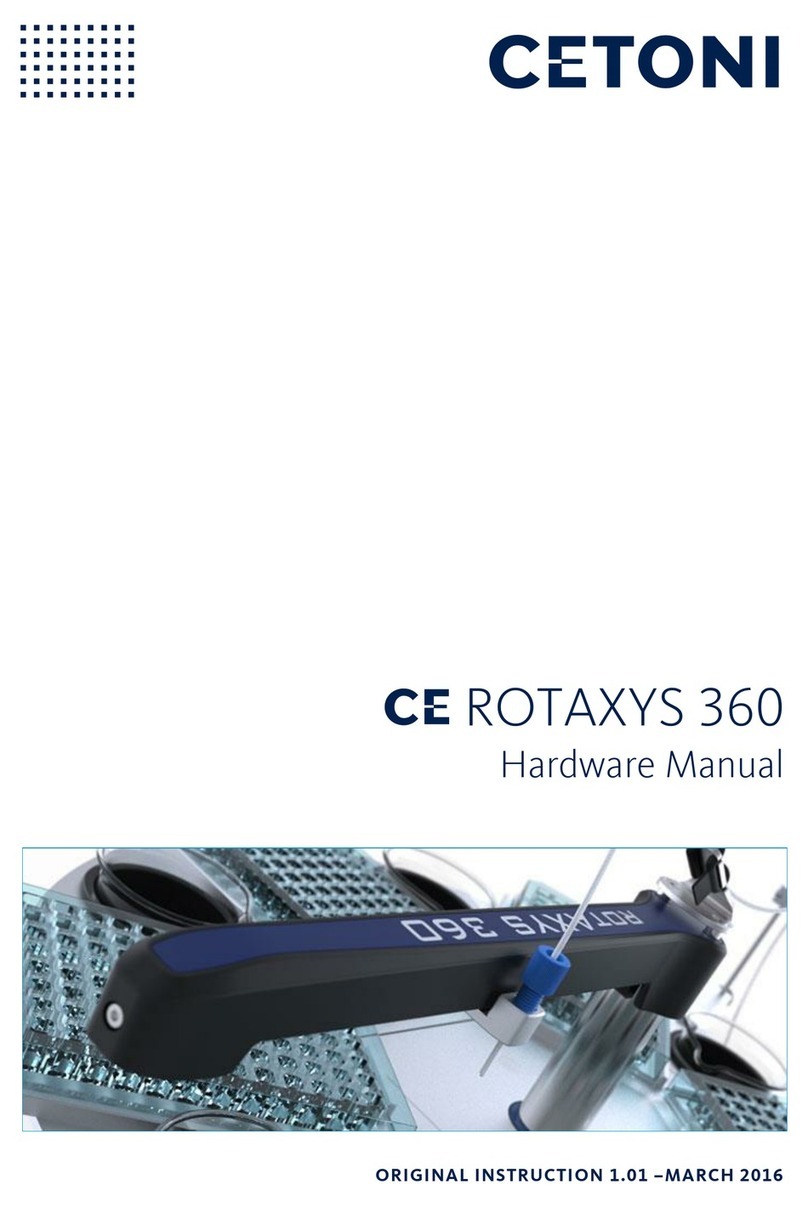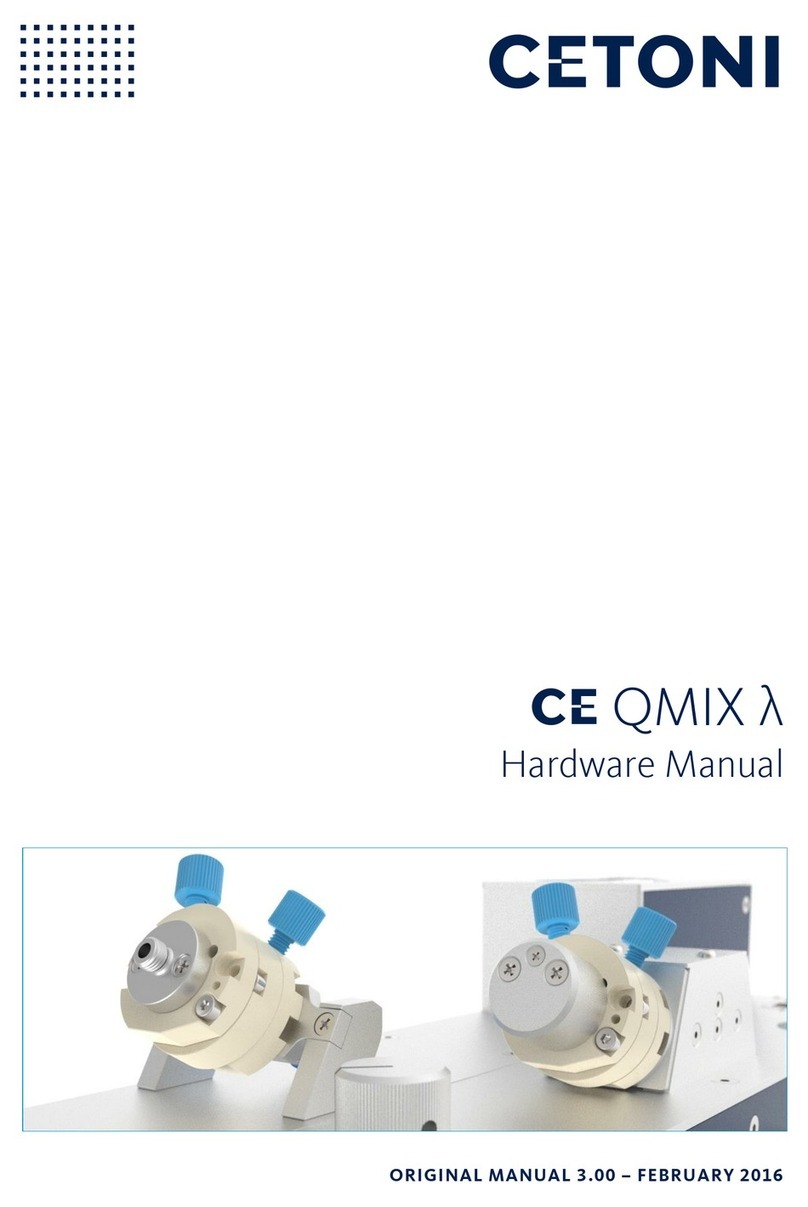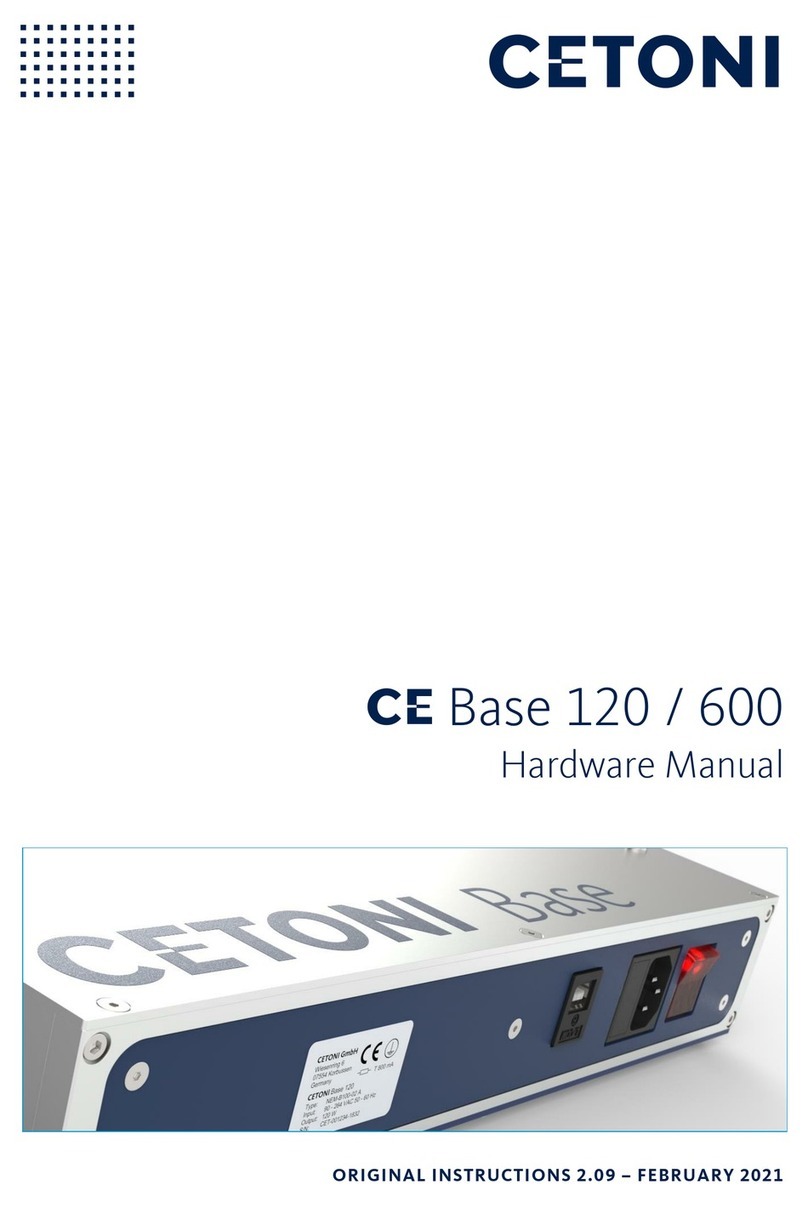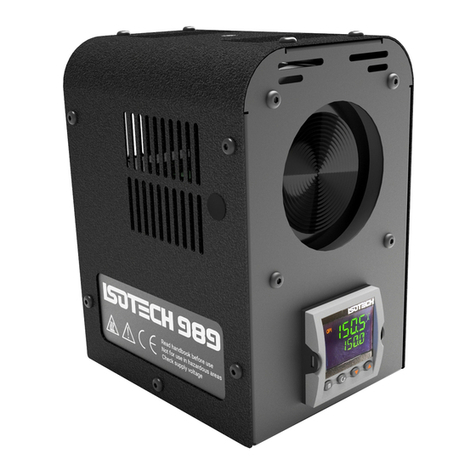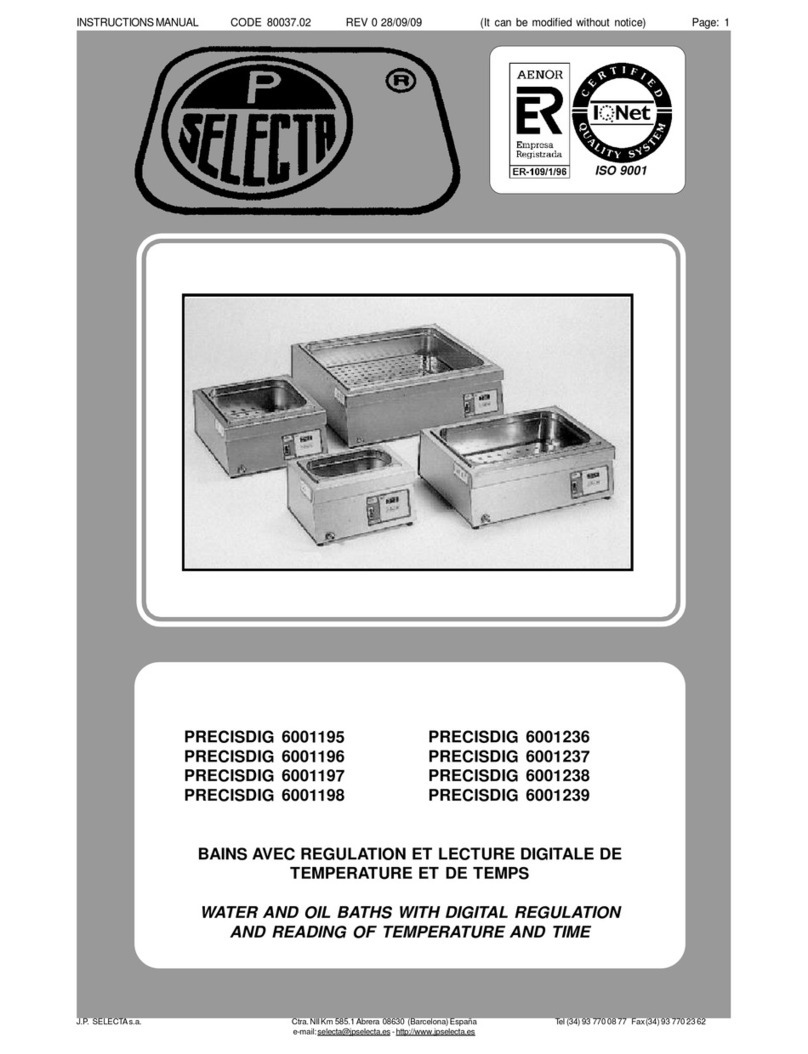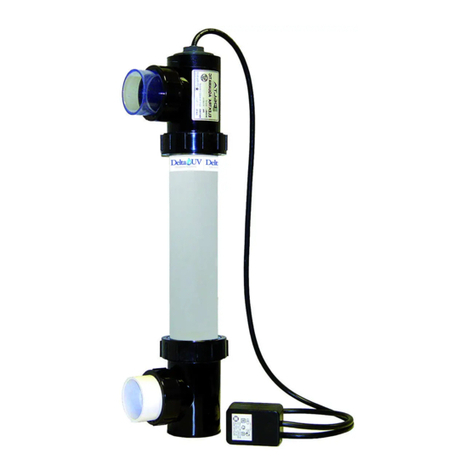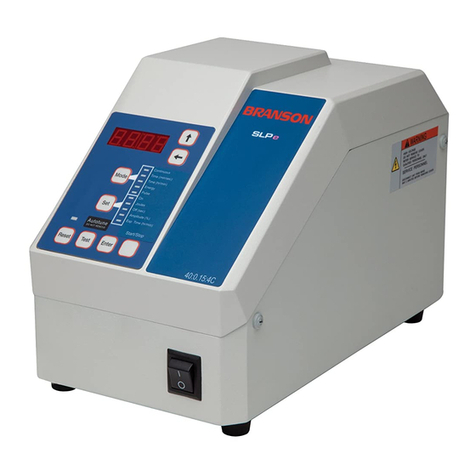cetoni neMESYS User manual

Original Setup and Operating Manual 2.01 –May 2015
neMESYS OEM
Hardware Manual

2neMESYS Hardware Manual
The information and data contained in this document are subject to change
without prior notice. No part of this document may be copied or transmitted
without the express consent of cetoni GmbH, irrespective of the means used for
this purpose –electronic or mechanical. The general terms of cetoni GmbH
apply. Agreements deviating from these terms must be made in writing.
Copyright © cetoni GmbH –Automation and Microsystems. All rights reserved.

neMAXYS Hardware Manual 3
Software License
The software and the supplied documentation are copyrighted material. By
installing the software you accept the terms of the licensing agreement.
License Agreement
cetoni GmbH grants the buyer the simple, non-exclusive and non-transferrable
right to use the software on a single computer or networked computer system
(LAN). Copying or any other duplication of the entire software or parts thereof or
mixing and connecting it with other software products is expressly prohibited.
For backup purposes the buyer may create a single copy of the software. Cetoni
GmbH reserves the right to alter, develop, improve or replace the software.
Cetoni is not obligated to inform the buyer with respect to modifications, new
developments or improvements or to supply them to him. Cetoni does not
legally warrant any particular software properties. Cetoni is not liable for any
damage, unless it is caused willfully or due to gross negligence on the part of
cetoni GmbH or its agents. Any liability for indirect, incidental or consequential
damage is excluded.

4neMESYS Hardware Manual
cetoni GmbH
Wiesenring 6
D- 07554 Korbussen
Germany
Tel.: +49 (0) 36602 338-0
Fax: +49 (0) 36602 338-11
E-Mail: [email protected]
Internet: www.cetoni.de

neMESYS Manual - Content 5
1. Overviews and Indexes
1.1. Content
1. Overviews and Indexes................................................................... 5
1.1. Content.................................................................................................... 5
1.2. Revision History....................................................................................... 8
2. Introduction ................................................................................... 9
2.1. Preface..................................................................................................... 9
2.2. Symbols and Keywords............................................................................ 9
3. Basic Information ......................................................................... 10
3.1. Standards and Guidelines...................................................................... 10
3.2. Intended Use ......................................................................................... 10
3.2.1. General Description of the Component................................................ 10
3.2.2. Proper Use............................................................................................. 11
3.2.3. Reasonably foreseeable Misuse............................................................ 11
3.2.4. Safety Measures.................................................................................... 11
3.2.5. Measures for safe Setup ....................................................................... 13
3.2.6. Safe Operation Measures...................................................................... 13
3.2.7. Condition of Devices ............................................................................. 14
3.3. Warranty and Liability ........................................................................... 14
4. Technical Data .............................................................................. 16
4.1. Performance Data ................................................................................. 16
4.2. Dimensional Drawing of Pump.............................................................. 18
4.3. Standard Valve ...................................................................................... 19
4.4. Dimensional Drawing of Valve .............................................................. 19
4.5. Dosing Performance .............................................................................. 20
5. Transport and Storage .................................................................. 21

6neMESYS Manual - Content
5.1. Transport ............................................................................................... 21
5.2. Maintenance and Care .......................................................................... 21
6. Hardware Operation .................................................................... 22
6.1. Installing a Syringe................................................................................. 22
6.2. Fluidic / Valve ........................................................................................ 25
6.3. Removing Valves ................................................................................... 27
7. Electrical Interfaces ...................................................................... 29
7.1. Overview ............................................................................................... 29
7.2. Power Supply (J1 / J2) ........................................................................... 30
7.2.1. Pin Assignment...................................................................................... 30
7.2.2. Technical Data....................................................................................... 30
7.3. CAN Interface (J3 / J4) ........................................................................... 32
7.3.1. Pin Assignment...................................................................................... 32
7.3.2. Technical Data....................................................................................... 32
7.3.3. Connecting neMESYS to CAN bus line CiA DS-102................................ 32
7.4. RS-232 Connection (J5) ......................................................................... 33
7.4.1. Pin Assignment...................................................................................... 33
7.4.2. Technical Data....................................................................................... 33
7.4.3. Connecting neMESYS to a PC ................................................................ 34
7.5. Signal Connection (J6) ........................................................................... 35
7.5.1. Pin Assignment...................................................................................... 35
7.5.2. Analog Input 1 and 2 (Pin 1 and 2)........................................................ 36
7.5.3. Digital Inputs 1 and 2 (Pin 3 and 4) ....................................................... 36
7.5.4. Digital Input 7 (Pin 5)............................................................................. 38
7.5.5. Digital Output 1 and 2 (Pin 6 and 7)...................................................... 39
7.5.6. Digital Output 5..................................................................................... 41
7.6. CAN-Bus Termination............................................................................ 43
7.7. Switching the integrated Valve ............................................................. 43
8. Cable Set ...................................................................................... 45
8.1. Power Cable .......................................................................................... 45
8.2. Power Connection cable ....................................................................... 45
8.3. CAN Cable (terminated DSub socket) ................................................... 46

neMESYS Manual - Content 7
8.4. CAN Cable (DSub plug) .......................................................................... 47
8.5. CAN Connection Cable........................................................................... 47
8.6. CAN Terminator..................................................................................... 48
8.7. RS232 Cable (DSub socket).................................................................... 49
8.8. USB-to-CAN Adapter ............................................................................. 49
9. Setup & Cable Connection............................................................ 51
9.1. Mechanical Setup .................................................................................. 51
9.2. Introduction to Cable Connection......................................................... 51
9.3. Step 1 –Connecting the Power Cable ................................................... 51
9.4. Step 2 –Data Connection...................................................................... 52
9.4.1. Introduction........................................................................................... 52
9.4.2. Data Connection through CAN.............................................................. 52
9.4.3. Data Connection through RS232........................................................... 53
9.5. Step 3 –Power Supply of additional Modules ...................................... 53
9.6. Step 4 –Data Connection to additional Modules ................................. 53
9.7. Step 5 –CAN Bus Termination .............................................................. 53
10. Disposal ...................................................................................... 55

8neMESYS Manual - Content
1.2. Revision History
Rev
Date
Modification
1.03
17.08.2010
Creation of Manual
2.00
09.01.2015
Revision for new Hardware
2.01
30.03.2015
RS232 cable modified (DSub jack instead of plug)
Added logic table for valve switching

neMESYS Manual - Introduction 9
2. Introduction
2.1. Preface
Thank you for purchasing a cetoni product. With this manual we would like to
support you in using the device. For additional questions or comments please
feel free to contact us directly.
2.2. Symbols and Keywords
This manual uses the following symbols, intended to help you navigate the
document:
TIP
User tips and useful information to simplify the use of the software.
IMPORTANT
Important information and additional, particularly useful information.
This symbol does not refer to dangerous or hazardous situations.
CAUTION
This symbol signifies a potentially hazardous situation. Failing to avoid it
may cause damage to the product or its environment.
WARNING
This symbol signifies a potentially dangerous situation. Failing to avoid
it may cause light or insignificant injury or material damage.

10 neMESYS Manual –Basic Information
3. Basic Information
3.1. Standards and Guidelines
neMESYS OEM-modules conform to the basic health and safety requirements
stipulated by the 2006/42/EC machine directive. The modules are incomplete
machines according to the 2006/42/EC machine directive and intended for
installation into a machine. According to the directive they do not bear the CE
mark.
Integrating the modules into a machine may cause additional risks. It is
imperative that you conduct a risk evaluation of your machine with the
integrated modules and take any safety measures necessary.
IMPORTANT
Please note that you may not use neMESYS OEM-modules until the
machine or plant into which the modules are integrated complies with
the 2006/42/EC machine directive and the declaration of conformity in
attachment II A has been issued.
3.2. Intended Use
3.2.1. General Description of the Component
neMESYS devices are syringe pumps. They enable emptying and filling of syringes
through a linear relative movement between a syringe holder and a piston
holder.
The OEM-module is not a complete machine as defined by the machine directive,
but an incomplete machine intended for installation into another machine or

neMESYS Manual –Basic Information 11
plant. Please refer to the information provided in chapter 9 of this manual with
respect to installation and cable connection.
3.2.2. Proper Use
The neMESYS syringe pump system is intended for high-precision and pulsation-
free dosing of fluids in a range from nanoliters to milliliters per second.
Depending on the device being used, pressures in excess of several hundred bar
may be reached. The devices are typically used in a lab-like environment.
3.2.3. Reasonably foreseeable Misuse
Using the devices in applications other than the ones intended for them may
create dangerous situations and must be avoided.
WARNING
The devices must not be used as medical devices or for medical
purposes.
3.2.4. Safety Measures
Operator safety and failure-free operation of the devices can only be guaranteed
when using original equipment parts. Only original accessories may be used.
Warranty claims are void if damage was caused by using third-party equipment
or third-party material.
The devices were developed and designed in such way as to largely rule out
dangers, if used properly. Nevertheless, you should observe the following safety
measures to rule out any residual danger.
cetoni GmbH would like to point out the operator’s responsibilities when
using the device. Local laws and regulations relevant to using this device must
be observed. In the interest of a safe work process the operator and user of
the device is responsible for observing all relevant laws and regulations.
The devices must not be used as medical products or for medical purposes.

12 neMESYS Manual –Basic Information
The device is designed and approved for operation in systems governed by
article 4 section 3 or the pressurized devices directive 2014/68/EU. This
means that he devices may not exceed a maximum volume of 1 liter. When
using group 1 fluids according to article 13 of the pressurized systems
directive 2014/68/EU, the maximum allowable system pressure is 200 bar. It
is 1000 bar for group 2 fluids. If the “Technical Data” section stipulates
different product-specific maximum pressure values, such values must be
observed. Particular attention must be paid to not exceeding the pressure
range of the respective sensor. The information provided in the “Technical
Data” section with respect to the maximum operating temperature must be
observed. cetoni GmbH is not liable for potential impacts caused by the user
extending the system with peripheral devices in a way that causes one or both
of these values to be exceeded. The operator is responsible for becoming
acquainted with the aforementioned pressurized systems directive and
observing applicable stipulations.
Before each operation of the device the user has to ensure that the device is
functioning safely and is in proper condition.
The user must be familiar with the operation of the device and the software.
Before starting operation, the devices and wiring must be checked for
damage. Damaged wires and plugs must be replaced immediately.
Cables must be routed in such way as to rule out any trip hazards.
Do not touch moving parts on the devices during operation. There is a risk of
crushing.

neMESYS Manual –Basic Information 13
Operating the devices in an explosive environment or with explosive
substances is prohibited!
Make sure to wear safety goggles during installation work on the device or
when you work with corrosive, hot or otherwise dangerous substances.
Transport, storage or operation at temperatures below 0°C with water in the
fluid channels may cause damage to the devices.
3.2.5. Measures for safe Setup
Mechanical and electrical installation of pumps may only be done by skilled
personnel.
Make sure that all devices are installed in line with local laws and regulations.
Please note that, principally, the OEM-pumps cannot be considered fail-safe.
You have to ensure that a failing pump will not cause damage to your
application by employing suitable safety and monitoring measures.
Please note that you are not authorized to repair cetoni devices or
components.
Make sure that the power supply is not active and cannot be activated while
conducting installation or wiring work on the devices.
3.2.6. Safe Operation Measures
3.2.6.1 Electromagnetic Emissions
The neMESYS syringe pump system is designed for usage in any facility directly
connected to a public supply network that also supplies buildings used for
residential purposes.

14 neMESYS Manual –Basic Information
3.2.6.2 ESD-Discharge
Floors should be wood or concrete or covered with ceramic tiles. If floors are
covered with synthetic material, relative air humidity must be at least 30%.
3.2.6.3 Electrical Disturbances
Supply voltage quality should be equal to a typical business or hospital
environment.
3.2.6.4 Magnetic Disturbances
Power lines, including those of other devices, should not be placed near the
device or its cables. Mobile two-way radios should be kept at the minimum safe
distance from the device and its wiring.
3.2.7. Condition of Devices
Despite flawless workmanship, the devices may be damaged during operation.
Therefore, you should visually inspect the device components mentioned before
each use. Pay particular attention to crushed cables, damaged hoses and
deformed plugs. If you find any damage, please refrain from using the devices
and contact cetoni GmbH immediately. We will repair your devices as soon as
possible. Never attempt to repair a device yourself.
3.3. Warranty and Liability
The devices left our facilities in perfect condition and may only be opened by
cetoni GmbH. If a device is opened by an unauthorized person, all warranty and
liability claims shall be void, in particular those referring to personal injury.
The warranty period is 1 year from the day of delivery. Any work done on the
devices within this period shall not extend or renew the warranty.
cetoni GmbH assumes responsibility for its devices with respect to safety,
reliability and function only if installation, readjustment, changes, extensions and

neMESYS Manual –Basic Information 15
repairs are done by cetoni GmbH or an authorized party, and if the devices are
used in accordance with the user manual.
The neMESYS syringe pump system complies with the applicable safety rules and
standards. cetoni GmbH reserves all property rights for the relevant wiring,
processes, names, software and devices.

16 neMESYS Manual –Technical Data
4. Technical Data
4.1. Performance Data
Electrical Data
Supply voltage VCC (ripple < 10%)
24 VDC
Peak current draw at 24 VDC
0.6 A
Typical current draw at 24 VDC
0.3 A
Inputs
Analog input 1 (AI1)
resolution 11-bit 0 ... +5 V (Ri = 34 kΩ)
Analog input 2 (AI2)
resolution 11-bit 0 ... +5 V (Ri = 34 kΩ)
Digital input 1 (DI1)
+3 … +36 VDC (Ri = 12 kΩ)
Digital input 2 (DI2)
+3 … +36 VDC (Ri = 12 kΩ)
Digital input 3 (DI7)
+3 … +36 VDC (Ri = 12 kΩ)
Outputs
Digital output 1 (DO1)
open collector, max. 36 VDC (IL < 50 mA)
Digital output 2 (DO2)
open collector, max. 36 VDC (IL < 50 mA)
Digital output 3 (DO5)
push pull, max. 36 VDC (IL < 10 mA)
Interfaces
CAN
CAN_H (high); CAN_L (low)
max. 1 Mbit / s (standard 1 Mbit / s)
RS232
RxD; TxD
max. 115200 bit / s (115200 bit / s)
Mechanical Data
Weight
approx. 1100 g
Dimensions (L x W x H)
310 x 47 x 130 mm
Attachments
M3 screws

neMESYS Manual –Technical Data 17
Ambient Conditions
Operating Temperature
-10 … +45°C
Storage Temperature
-40 … +85°C
Air Humidity
Non-condensing 20 … 80 %
Sound power level
< 70 dB(A)
Connections
Power
supply
on device: two-row pin connector (2-pole type) Molex Mini Fit Jr
plug connector: two-row socket (2-pole type)
Molex Mini-Fit Jr. 39-01-2020
crimp contacts: crimp socket Molex Mini-Fit Jr.TM 444-76-1111 (AWG 18-24)
CAN
on device: 3-pole plug JST XARR-03V
plug connector: 3-pole socket JST XAP-03V-1
RS232
on device: 4-pole plug JST XARR-04V
plug connector: 4-pole socket JST XAP-04V-1
Signal
on device: 12-pole plug JST XARR-12V
plug connector: 12-pole socket JST XAP-12V-1

18 neMESYS Manual –Technical Data
4.2. Dimensional Drawing of Pump

neMESYS Manual –Technical Data 19
4.3. Standard Valve
Valve
Housing material
PEEK
Sealing material
FFKM (perfluoroelastomer)
Media temperature
0 to +50°C
Max. viscosity
21 mm²/s
Internal volume
approx. 45 µl
Max. pressure
3 bar
Rated width
0.6 mm
Fluidic connections
¼“ – 28 UNF
4.4. Dimensional Drawing of Valve
CAUTION
There is a danger of damaging the housing or sealing material.
Before using the valve for the first time, please check the chemical
compatibility of the media you want to use with the PEEK housing
material and the FFKM (perfluoroelastomer) sealing material.
output (normally open)
input (normally closed)
syringe
seals
PEEK

20 neMESYS Manual –Technical Data
4.5. Dosing Performance
The following table provides an overview of the minimum and maximum dosing
speeds of the various gear configurations as well as the resulting flow rates,
using the example of a 1ml syringe with a 60 mm stroke.
Speeds and flow rates lower than those referred to as pulsation-free, will cause
dosing precision to decrease slowly.
Gear
w/o
14:1
29:1
Min. speed [µm/s]
0.065
0.065
0.065
Min. pulsation-free speed [µm/s]
14.648
1.042
0.502
Max. speed [mm/s]
89
6.33
3.06
1 ml syringe
with 60 mm
stroke
Min. flow [µl/min]
0.065
0.065
0.065
Min. pulsation-free flow [µl/min]
14.648
1.042
0.502
Max. flow [ml/min]
89
6.33
3.05
Other manuals for neMESYS
2
Table of contents
Other cetoni Laboratory Equipment manuals
Popular Laboratory Equipment manuals by other brands

Phase Technologies
Phase Technologies 70Xi Quick installation guide

RBCBioscience
RBCBioscience MagCore Super Engineer in Training Manual
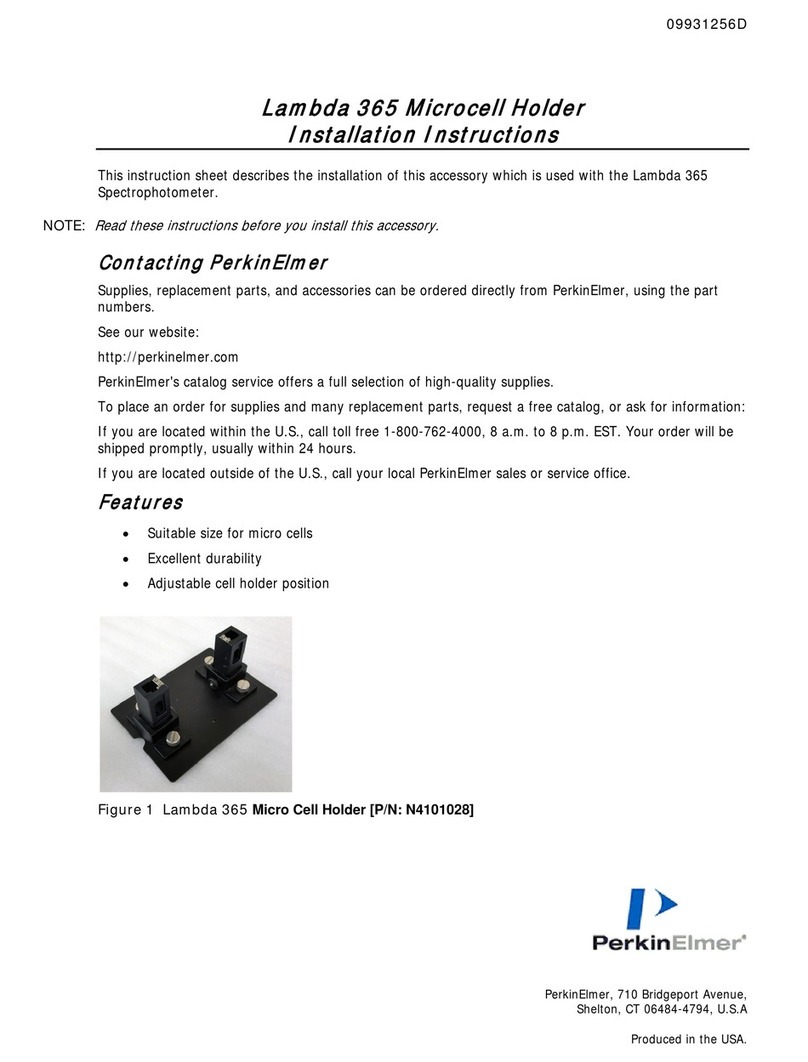
PerkinElmer
PerkinElmer Lambda 365 installation instructions
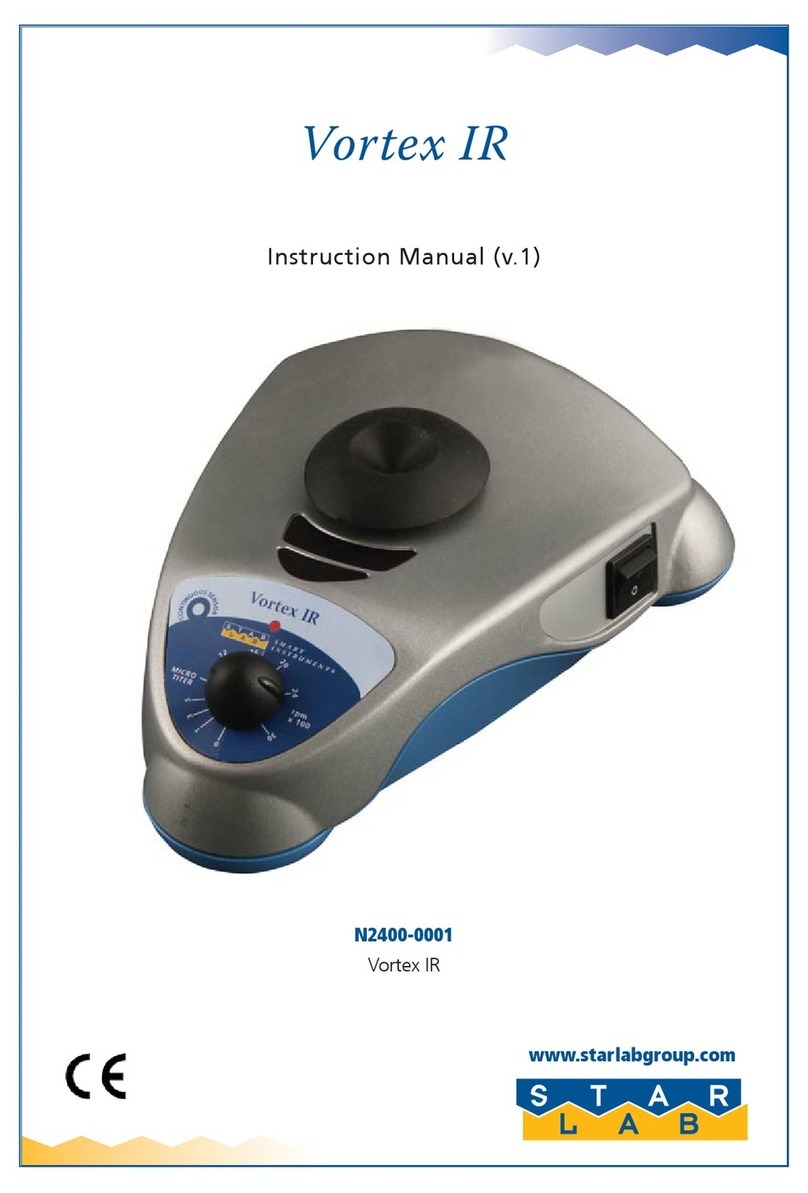
Star Lab
Star Lab N2400-0001 Vortex IR instruction manual
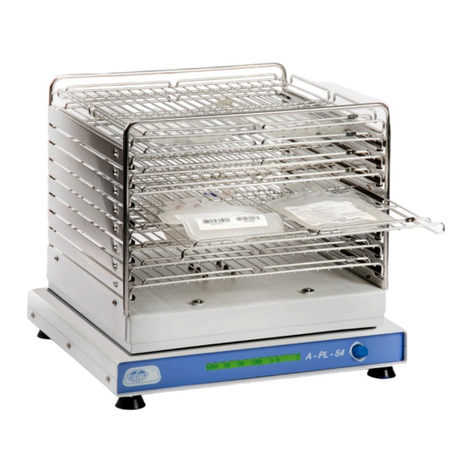
J.P. SELECTA
J.P. SELECTA APL-54 manual
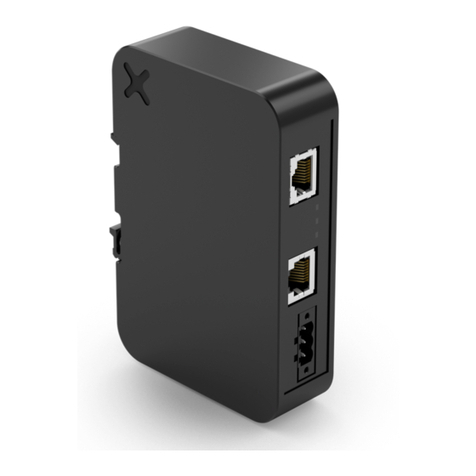
Exor
Exor JSPOU0P1 installation guide
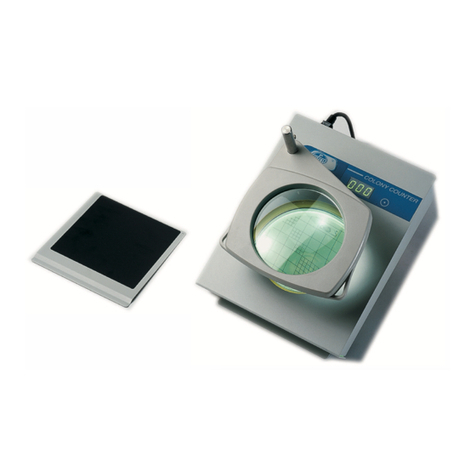
J.P. SELECTA
J.P. SELECTA DIGITAL-S instruction manual

Cooper Surgical
Cooper Surgical K-Systems R65 user manual
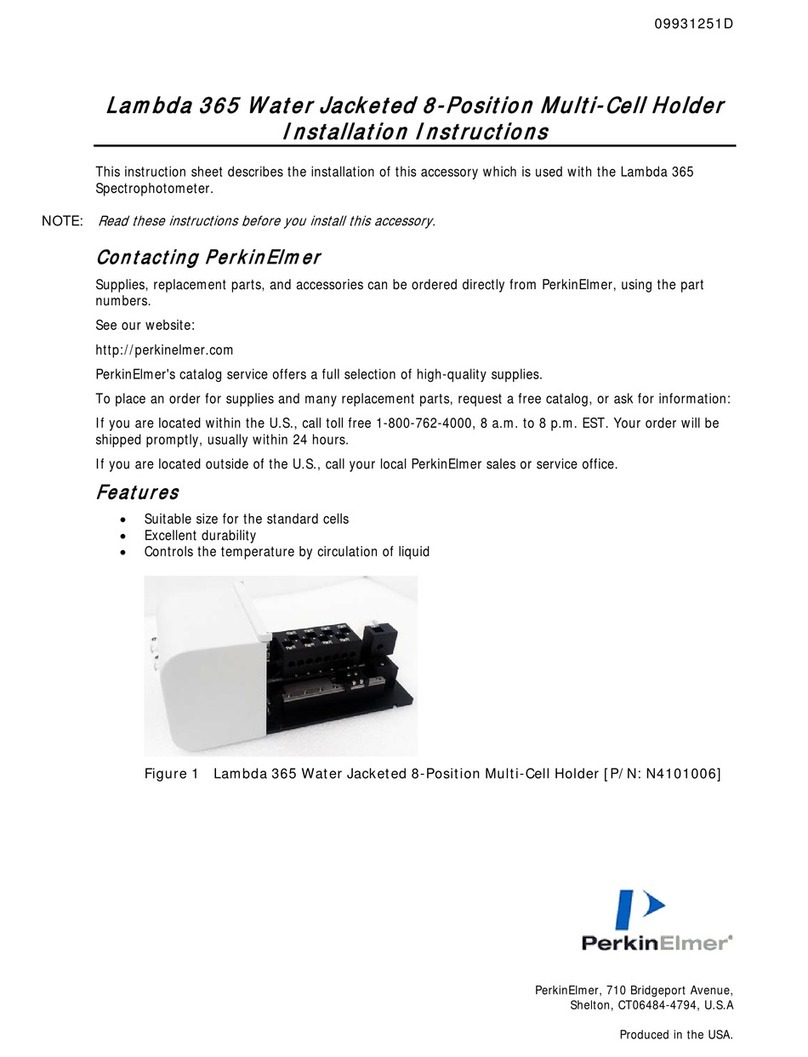
PerkinElmer
PerkinElmer Lambda 365 installation instructions
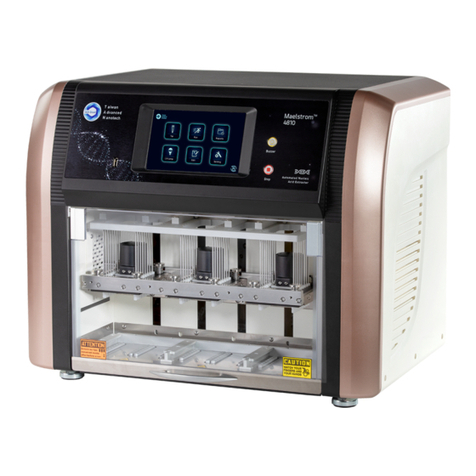
TAN Bead
TAN Bead Maelstrom 4810 user manual
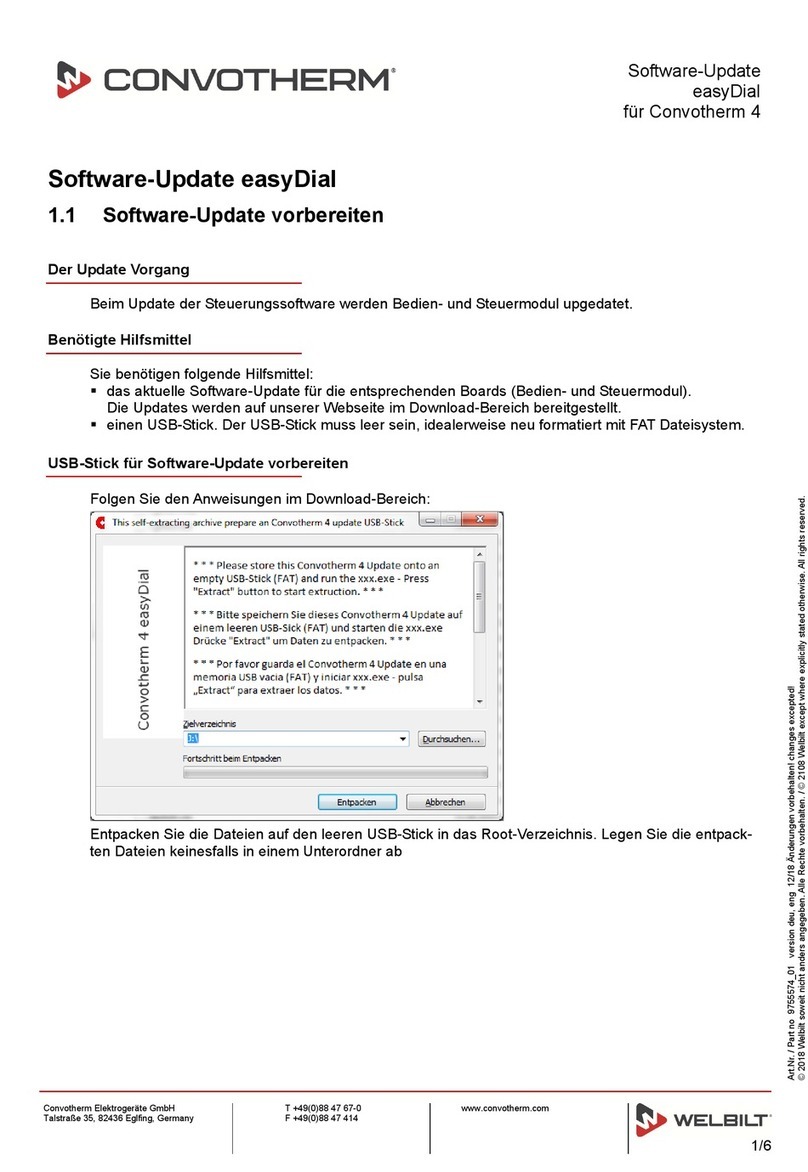
Welbilt
Welbilt Convotherm easyDial Update manual
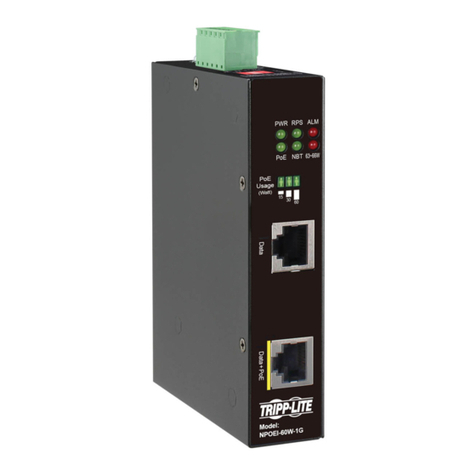
Tripp Lite
Tripp Lite NPOEI-60W-1G quick start guide
